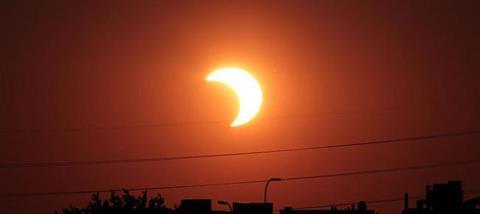
Today, the Arctic and Northern Europe, including the UK, will witness a total solar eclipse, representing the first total solar eclipse in Europe in more than a decade. An eclipse occurs when the moon passes between the sun and the earth. Since the sun is four hundred times bigger than the moon, but also coincidentally four hundred times further away, the sun and the moon appear to be the same size in the sky. Remarkably, of the many moons in our Solar System, our moon is the only one known to yield the most perfect solar eclipses when viewed from the surface of the earth.
It is enough to send a chill down one’s spine. Is it just down to happy coincidence that the one planet in the solar system that yields the most perfect solar eclipses just so happens to be the one planet that harbours conscious observers to appreciate them? Only one other moon in the solar system appears the same size when viewed from its host planet – a small moon of Saturn called Prometheus. But this moon moves so rapidly around Saturn that its solar eclipses endure for less than a single second.
"The one planet in the solar system that yields the most perfect solar eclipses just so happens to be the one planet that harbours conscious observers to appreciate them"
Solar eclipses are a spectacular sight to behold. But they have also contributed significantly to scientific discovery. The sun’s corona, the star’s outer atmosphere, becomes observable only during a solar eclipse. This has allowed scientists to conduct experiments during solar eclipses, and this has enabled researchers to use spectroscopes to discern the spectra of stars.
In 1919, a solar eclipse led to the confirmation of Einstein’s theory of General Relativity that he had proposed three years earlier. If Einstein's theory was right, starlight should bend as it passes the sun. Researchers, one group led by Arthur Eddington and Edwin Cottingham on Principle Island off the West African coast and another group in Brazil led by Andrew Cromellin and Charles Davidson, set out to determine the changes in the position of stars in the sky near the sun relative to their position before and after the eclipse. Their data ultimately confirmed Einstein’s theory of general relativity. These results have been borne out by subsequent experiments conducted during solar eclipses.
"Solar eclipses have played an important part in the scientific endeavour"
Examining ancient records of solar eclipses at known places and times has also enabled scientists to elucidate the Earth’s past rotation rate. This has even allowed historians to translate ancient calendar systems into a modern calendar system.
It is clear, then, that solar eclipses have played an important part in the scientific endeavour. Is it merely an uncanny fortuitous state of affairs that the one planet in our solar system on which there are observers also happens to be the one planet with perfect solar eclipses that appear to provide optimal conditions for scientific discovery?
In their book The Privileged Planet, astronomer Guillermo Gonzalez and philosopher Jay W. Richards elaborate on this and many other uncanny coincidences that suggest that there is significant overlap between the conditions necessary for habitability and those that are conducive to measurability.
While this striking phenomenon does not by any means clinch the design hypothesis, it certainly adds to a growing cumulative body of data that suggests that our Universe was designed for intelligent life.
Something to think about as you watch (or attempt to watch) today’s solar eclipse.
Image: NASA Goddard Space flight centre, Flickr
Jonathan McLatchie is a science student studying for a PhD. Hear his Unbelievable? radio debate here




























